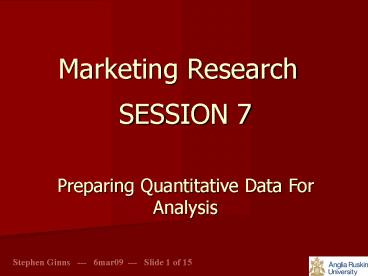Marketing Research - PowerPoint PPT Presentation
1 / 15
Title:
Marketing Research
Description:
how statistical techniques may be used to evaluate the significance of quantitative data ... Week 12 4th May - Bank Holiday no lecture/workshops ... – PowerPoint PPT presentation
Number of Views:74
Avg rating:3.0/5.0
Title: Marketing Research
1
Marketing Research
SESSION 7 Preparing Quantitative Data For
Analysis
2
Session Objectives
- the role of editing, coding, counting and
interpretation of data - coding a simple questionnaire
- how statistical techniques may be used to
evaluate the significance of quantitative data - the features of a good, commercially credible
marketing research report
3
Analysing Quantitative Data
- Manually
- Counting up answers
- Frequencies and percentages
- Using computer package
- Excel, SPSS, SNAP
- Frequencies and cross-tabulations
- Statistical techniques
- Building up the picture of the data
4
Analysing Quantitative Data
- Prepare the data
- Edit
- Check questionnaires for errors or omissions
- Coding
- Allocating a numerical code for each possible
answer - Data Input
- Data Cleansing
- Data Processing
- Data Mining
- Statistical Analysis
- Presentation
5
Questionnaire Coding
- A method of inputting data from a questionnaire
in the form of numerical codes
6
Coding Single Response Questions
- Q12 To which of the following age groups do you
belong? - 18-25 (1)
- 26-34 (2)
- 35-44 (3)
- 45-54 (4)
- 55 (5)
7
Coding Multiple Response Questions
- Q3 Which of the following Supermarkets have you
visited in the last month in order to purchase
your main grocery shopping? - q3a Asda 1 Yes, 2 No
- q3b Tesco 1 Yes, 2 No
- q3c Sainsbury 1 Yes, 2 No
- q3d Morrisons 1 Yes, 2 No
8
Data Input
- Time Consuming
- Human Error
- Build into schedule
- Can pay third party
- OMR (Optical Mark Recognition)
- Using OMR form
- Each questionnaire read in
9
Data Cleansing
- Check for human error
- Computer may identify responses it does not
recognise - Time consuming but gets data ready for analysis
- Makes optimum use of all responses gained
10
Data Analysis
- What is the story of the data?
- What comparisons are suggested?
- What trends or relationships are observed?
- How reliable and meaningful is the data?
- Are you interpreting it correctly?
11
Data Analysis
- Frequencies
- Cross Tabulations
- Statistical Significance
- Looking at relationships
- Significance of results
12
Statistical Analysis
- Statistical Analysis
- Descriptive statistics , describing large masses
of numbers - Inferential statistics, drawing conclusions
13
Simple Measures
- Frequencies
- Gender of respondents, age of respondents, income
- Numbers of responses against each question
- Compile as a percentage of the whole
- Cross Tabulations
- Table setting out responses to one question
relative to others - Cumulative Frequency
- Average
- Arithmetic Mean
- The median
- The mode
14
Are Results Significant?
- Confidence Testing
- How confident are we that our sample results are
true for the whole population? (95, 99) - All statistics used with care
- Compare results with known factors about the
total population
15
Forward Plan
- Week 8 16th March - no lecture go straight to
209 at 3pm - Week 9 23rd March - no lecture go straight to
209 at 3pm - Easter break (3 weeks)
- Week 10 20th April - Lecture Reports and
Layout - Week 11 27th April - no lecture go straight
to 209 at 3pm I can review submissions for
pass/fail - Week 12 4th May - Bank Holiday no
lecture/workshops - Week 13 Tuesday 13th May Hand-in date

